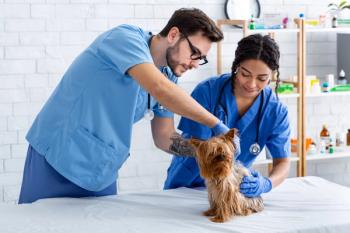
Red in tooth and clawand how to keep both away from your face
You, dear veterinary professional, dont go out looking to be bitten or scratched, yet you probably have some sort of battle scar from a bad encounter. Heres how to prevent any more from happening in the future.
Kind Illustration/stock.adobe.com
Here are the facts: No one wants to be bitten, and we never think it'll happen to us-but it does. No one is at more risk of being bitten by an animal than a veterinary team member trying to care for a sick or injured patient. We sometimes think our skills and reflexes are better than average so we'll be able to respond to a problem fast enough.
Or maybe we're of the opinion that the 30 seconds it takes to protect oneself would somehow endanger the well-being of our patient. Or maybe it's just complacency. Whatever the reason, animal-inflicted injuries such as bites are the most common injuries to veterinary professionals. And it seems the most frequent violators of bite prevention techniques are often those who have not suffered a serious injury … yet!
One of the most vulnerable times for bites is when retrieving an injured or aggressive animal from a vehicle. Bites to the face, neck and hands are extremely painful and disfiguring. Animals react to situations and to stimuli, including pain, fear or territoriality. So when a person sticks their head in the back seat of the car, they not only intrude on the animal's space, they put their most vulnerable body part-their face and neck-in close proximity to the animal's primary defense mechanism-their mouth! Then when the animal reacts, all the ingredients are in place for a bad event.
Even in an emergency situation where time is of the essence, rushing headlong into the situation without following proper procedure is a recipe for disaster. Most bite prevention techniques add less than a minute to the length of the procedure, but failure to take precautions can mean immediate and sometimes permanent disfigurement and pain. Not to mention that you won't be able to help any animals while being treated for your injury or during your recovery. If you think it's hectic now, how's that injury going to affect the schedule?
Since it's impossible to accurately predict which animals will bite and which one ones won't, it's important to incorporate these prevention steps into every encounter with a distressed animal that must be removed from a vehicle:
Get help when possible. It's always safer when there are two people handling an injured or stressed animal in a vehicle.
Approach the patient from posterior side. If the animal is injured and immobile, to judge the level of their pain or complacency upon first contact-don't go straight for the end with the teeth! If the animal is cooperative, move to the head of the patient to proceed.
Put a slip leash on the animal. After this, pass the leash through the window of the opposite door. Have someone hold on to the leash while you assess the patient's condition or apply a muzzle. That way, the assistant can restrict the animal's movement if they make any aggressive moves while you are in a vulnerable position.
Always apply a muzzle. Before attempting any physical manipulation or movement of a distressed patient, apply a muzzle, as the movement will likely illicit a pain response. Lightweight nylon muzzles with quick release snaps are cheap, easy and most animals tolerate them readily.
Use a portable stretcher or cart. Take this approach instead of carrying the patient, even small ones. The stability of the stretcher will make the patient more comfortable and less likely to react negatively. And the distance to the patient will allow extra time to react if they do attempt to bite.
In the end, the needs of the patient are important, but we should be smart in delivering on those needs. Self-preservation is essential for veterinary staff members!
Want this in handout format for your next team training meeting? We've got you covered.
Phil Seibert, CVT, is based in Calhoun, Tennessee. He specializes in OSHA issues and is the author of The Complete Veterinary Practice Regulatory Compliance Manual (6th Edition).
Newsletter
From exam room tips to practice management insights, get trusted veterinary news delivered straight to your inbox—subscribe to dvm360.




